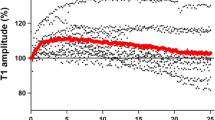Abstract
During general anesthesia, different modes of nerve stimulation are used for estimation of the degree of neuromuscular blockade. When switching between the different modes, it is important to know whether the preceding mode influences the responses to the succeeding mode, and, if so, for how long.
The object of our study was to determine the number of stimulations required for stabilization of the muscular response when switching between double-burst stimulation (DBS) applied every 20 sec, train-of-four (TOF) applied every 12 sec, and posttetanic count (PTC) at surgical degrees of neuromuscular blockade.
A total of 33 women were anesthetized with fentanyl, thiopental, halothane, and nitrous oxide. A constant degree of neuromuscular blockade was maintained at a twitch height of 4 to 11% of the control twitch height using a continuous infusion of atracurium.
The ulnar nerve was stimulated supramaximally at the wrist, and the contraction in the adductor pollicis was measured mechanomyographically. At surgical degrees of neuromuscular blockade, only the first twitch response to TOF stimulation (T1) and the first twitch response to DBS stimulation (D1) are consistently present.
When switching from DBS to TOF, 4 to 7 stimulations (56 to 92 sec) were required for stabilization of the T1 response. When switching from TOF to DBS, 3 stimulations (36 to 52 sec) were required for stabilization of the D1 response, and, finally, when switching from PTC to DBS, 5 to 11 stimulations (81 to 201 sec) were required for stabilization of the D1 response. Stabilization of D1 was faster following TOF than following PTC (p<0.01).
We conclude that, when switching between different modes of nerve stimulation, the number of stimulations required for stabilization of the responses to the succeeding mode of stimulation depends on the preceding mode.
Similar content being viewed by others
References
Ali HH, Utting JE, Gray C. Stimulus frequency in the detection of neuromuscular block in humans. Br J Anaesth 1970;42:967–977
Engbaek J, Oestergaard D, Viby-Mogensen J. Double burst stimulation (DBS): A new pattern of nerve stimulation to identify residual neuromuscular block. Br J Anaesth 1989;62:274–278
Drenck NE, Ueda N, Olsen NV, et al. Manual evaluation of residual curarization using double burst stimulation. Anesthesiology 1989;70:578–581
Gissen A, Katz RL. Twitch, tetanus and posttetanic potentiation as indices of nerve-muscle block in man. Anesthesiology 1969;30:481–487
Waud BE, Waud DR. The relation between the response to “train-of-four” stimulation and receptor occlusion during competitive neuromuscular block. Anesthesiology 1972;37:413–416
Viby-Mogensen J, Howardy-Hansen P, Chraemmer-Joergensen B, et al. Posttetanic count (PTC): A new method of evaluating an intense nondepolarizing neuromuscular blockade. Anesthesiology 1981;55:458–461
Viby-Mogensen J. Neuromuscular monitoring. In: Miller RD, ed. Anesthesia. New York: Churchill Livingstone, 1992:1209–1226
Kirkegaard-Nielsen H, May O. Double burst stimulation for monitoring profound neuromuscular blockade: A comparison with posttetanic count and train-of-four. Acta Anaesth Belg 1992;43:253–257
Brull SJ, Connelly NR, O'Connor TZ, Silverman DG. Effect of tetanus on subsequent neuromuscular monitoring in patients receiving vecuronium. Anesthesiology 1991;74:64–70
Hughes JR, Morrell RM. Posttetanic changes in the human neuromuscular system. J Appl Physiol 1957;11:51–57
Lee C, Katz RL. Neuromuscular pharmacology. A clinical update and commentary. Br J Anaesth 1980;52:173–188
Feldman SA, Tyrrell MF. A new theory of the termination of action of the muscle relaxants. Proc Roy Soc Med 1970;63:692–695
Howardy-Hansen P, Viby-Mogensen J, Gottschau A, et al. Tactile evaluation of the posttetanic count (PTC). Anesthesiology 1984;60:372–374
Viby-Mogensen J. Clinical assessment of neuromuscular transmission. Br J Anaesth 1982;54:209–222
Haykin S. Adaptive filter theory. Englewood Cliffs, NJ: Prentice-Hall, 1991:370–372
Sigel S, Castellan NJ. Nonparametric statistics for the behavioural sciences. New York: McGraw-Hill, 1988:205–216
Lee CM. Train-of-four quantitation of competitive neuromuscular block. Anesth Analg 1975;54:649–653
Bayly PJM. Frequency of repeated neuromuscular stimulation. Anaesthesia 1990;45:171
Curran MJ, Donati F, Bevan DR. Onset and recovery of atracurium and suxamethonium-induced neuromuscular blockade with simultaneous train-of-four and single twitch stimulation. Br J Anaesth 1987;59:989–994
Bell PF, Gibson FM, Mirakhur RK, Clarke RSJ. Comparison of single twitch and train-of-four modes of stimulation for measurement of non-depolarizing neuromuscular block. Br J Anaesth 1988;60:343P
Cooper RA, Mirakhur RK, Elliott PE, McCarthy GJ. Estimation of the potency of ORG 9426 using two different modes of nerve stimulation. Can J Anaesth 1992;39:139–142
Maddineni VR, Mirakhur RK, Cooper RA, McCoy E. Potency estimation of mivacurium: Comparison of two different modes of nerve stimulation. Br J Anaesth 1993;70:694–695
Meretoja OA, Taivainen T, Brandom BW, Wirtavuori K. Frequency of train-of-four stimulation influences neuromuscular response. Br J Anaesth 1994;72:686–687
Magleby KL, Zengel JE. A quantitative description of stimulation-induced changes in transmitter release at the frog neuromuscular junction. J Gen Physiol 1982;80:613–638
Bowman WC. Pharmacology of neuromuscular function. London: Wright, 1990:60–63
Gill SS, Donati F, Bevan DR. Clinical evaluation of double burst stimulation. Its relationship to train-of-four stimulation. Anaesthesia 1990;45:543–548
Author information
Authors and Affiliations
Rights and permissions
About this article
Cite this article
Kirkegaard-Nielsen, H., Helbo-Hansen, H.S., Lindholm, P. et al. Stabilization of the neuromuscular response when switching between different modes of nerve stimulation at surgical degrees of neuromuscular blockade. J Clin Monitor Comput 11, 317–323 (1995). https://doi.org/10.1007/BF01616990
Received:
Revised:
Accepted:
Issue Date:
DOI: https://doi.org/10.1007/BF01616990




